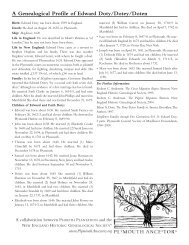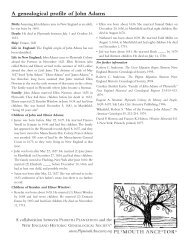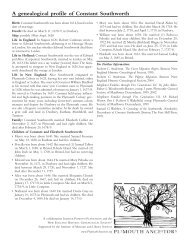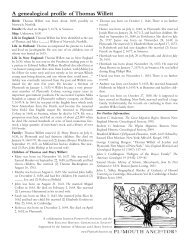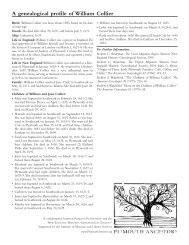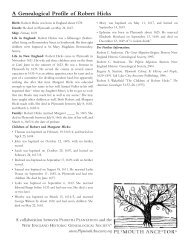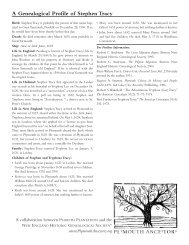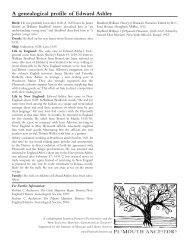Thomas Blossom - Plimoth Plantation
Thomas Blossom - Plimoth Plantation
Thomas Blossom - Plimoth Plantation
You also want an ePaper? Increase the reach of your titles
YUMPU automatically turns print PDFs into web optimized ePapers that Google loves.
A genealogical profile of <strong>Thomas</strong> <strong>Blossom</strong>Birth: He was born about 1580, probably the son of Peter andAnnabel <strong>Blossom</strong> of Great Shelford, Cambridgeshire.Death: He died in Plymouth before March 25, 1633.Ship: Mayflower, 1629Life in England: If the above identification is correct,<strong>Thomas</strong><strong>Blossom</strong> was one of at least seven children born to Peter<strong>Blossom</strong> and his second wife, Annabel _____. The <strong>Blossom</strong>slived first at Great Shelford, then possibly Little Shelford, andmoved to Stapleford, probably about 1582. He described himselfas a”husbandman” [small farmer] in a 1585 deposition, butas a “labourer” in his 1597 will, indicating a lower economic status.After his death, his wife married (2) Richard Bracher atStapleford on February 6, 1597/8, and moved with him toCambridge.The educated language of <strong>Thomas</strong> <strong>Blossom</strong>’s lettersto William Bradford have led some to speculate that <strong>Blossom</strong>attended Cambridge University, but there is no mention of hisname in university records.Life in Holland: <strong>Thomas</strong> <strong>Blossom</strong> arrived in Leiden beforeOctober 27, 1609. His occupation while there was not recorded.He was one of the passengers of the Speedwell (companionof the Mayflower in the 1620 voyage) which turned back due toleakiness and was ultimately abandoned. He returned to Leidenuntil he and others emigrated to Plymouth Colony in 1629.Life in New England: <strong>Thomas</strong> <strong>Blossom</strong> and his family sailedfrom England in March 1629 aboard the Mayflower (not theoriginal ship) and arrived in Salem on March 15, 1629. Theywere brought to Plymouth by boat and lived there until <strong>Thomas</strong>died in the “infectious feaver” of 1632/3.Family: <strong>Thomas</strong> <strong>Blossom</strong> married Anne Elsdon on November10, 1605, at St. Clement, Cambridge, Cambridgeshire and hadsix children. She married (2) Henry Rowley at Plymouth onOctober 17, 1633.Children of <strong>Thomas</strong> and Anne <strong>Blossom</strong>:• A child was buried at Pieterskerk in Leiden on February 15,1617.• A child was buried at Pieterskerk in Leiden on April 12, 1617.• A son was born by 1620. He died in Leiden by December 15,1625.• Elizabeth was born about 1620 in Leiden. She married (1)Edward FitzRandolph in Scituate on May 10, 1637, and hadnine children He died in Piscataway, New Jersey, about 1675.She married (2) John Pike in Piscataway but had no knownchildren.• <strong>Thomas</strong> was born about 1623. He married Sarah Ewer onJune 18, 1645, in Barnstable and had one daughter. Hedrowned off Nauset Beach on April 22, 1650.• Peter was born after 1627. He married Sarah Bodfish on June21, 1663, at Barnstable and had seven children. He died in July1706.For Further Information:Robert C. Anderson. The Great Migration Begins. Boston: NewEngland Historic Genealogical Society, 1995.Robert C. Anderson. The Pilgrim Migration. Boston: NewEngland Historic Genealogical Society, 2004.John Insley Coddington and Maclean W. McLean. “The<strong>Blossom</strong> Family of Cambridgeshire, England, and NewEngland.” The American Genealogist 63 (1989): 65–77, 238–246;64 (1988): 23–31. 1988–1989.A collaboration between PLIMOTH PLANTATION and theNEW ENGLAND HISTORIC GENEALOGICAL SOCIETY ®Supported by the Institute of Museum and Library Serviceswww.PlymouthAncestors.org
Researching your family’s history can be a fun, rewarding, and occasionallyfrustrating project. Start with what you know by collecting informationon your immediate family. Then, trace back through parents,grandparents, and beyond.This is a great opportunity to speak to relatives,gather family stories, arrange and identify old family photographs, anddocument family possessions that have been passed down from earliergenerations.Once you have learned all you can from family members, you willbegin to discover other sources. A wide variety of records can help you learn more about the lives of your ancestors.Theseinclude birth, marriage, and death records; immigration and naturalization records; land records; census records; probate recordsand wills; church and cemetery records; newspapers; passenger lists; military records; and much more.When you use information from any source — an original record, a printed book, or a website — always be careful to documentit. If you use a book, you should cite the author or compiler, the full title, publication information and pages used.Alsobe sure to record the author’s sources for the information. If the author’s sources aren’t provided, you will have to try to findthe original source. Many genealogical works contain faulty information, and the Internet also contains many inaccuracies. Inorder for your work to be accepted — by lineage societies and other genealogists — it must be properly documented.IMPORTANT GENEALOGICAL RESOURCESNew England Historic Genealogical SocietyFounded in 1845, NEHGS is the country’s oldest and largestgenealogical society.The library contains over 200,000 books,plus significant manuscript and microfilm collections, and a circulatinglibrary by mail. NEHGS members receive two periodicals,the Register and New England Ancestors, and can accessvaluable genealogical data online.NEHGS, 101 Newbury St., Boston, MA 02116;888-296-3447; www.NewEnglandAncestors.org.<strong>Plimoth</strong> <strong>Plantation</strong>: Bringing Your History To LifeAs a non-profit, educational organization our mission is: to offerthe public powerful experiences of history, built upon thoroughresearch of the Wampanoag and Pilgrim communities.We offermultiple learning opportunities to provide a deeper understandingof the relationship of historical events to modern America.Members have access to our Research Library.<strong>Plimoth</strong> <strong>Plantation</strong>, 137 Warren Avenue, Plymouth, MA 02632;508-746-1622; www.plimoth.orgRECOMMENDED WEBSITES• www.PlymouthAncestors.org• www.CyndisList.com• www.FamilySearch.org• www.USGenWeb.orgGENEALOGICAL LIBRARIES IN PLYMOUTHGeneral Society of Mayflower Descendants LibraryA collection focused principally on the genealogies of thedescendants of the Mayflower passengers.4 Winslow St., Plymouth; 508-746-3188; www.mayflower.orgPlymouth Collection, Plymouth Public LibraryOver 1200 items relating to the descendants of the Pilgrims, aswell as the many other immigrants who settled in the area.132 South St., Plymouth; 508-830-4250;www.plymouthpubliclibrary.orgRECOMMENDED BOOKSThe Complete Idiot’s Guide to Genealogy by Christine Rose andKay Germain Ingalls,Alpha Books, 1997.Genealogist’s Handbook for New England Research by MarciaMelnyk, NEHGS, 1999.Shaking Your Family Tree:A Basic Guide to Tracing Your FamilyHistory by Ralph J. Crandall, NEHGS, 2001.Unpuzzling Your Past by Emily Croom, Betterway Books, 2003.A collaboration between PLIMOTH PLANTATION and theNEW ENGLAND HISTORIC GENEALOGICAL SOCIETY ®www.PlymouthAncestors.org



